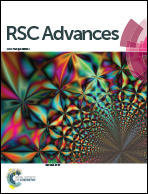Selective removal of toxic organic dyes using Trӧger base-containing sulfone copolymers made from a metal-free thiol-yne click reaction followed by oxidation†
Abstract
Three copolymers TCP1–3 bearing Trӧger's base (TB) units intercalated with various thioether groups were synthesized using a catalyst-free thiol-yne click reaction. TCP1–3 display excellent solubility in common organic solvents allowing for their structural, and photophysical characterization. The thioether groups in TCP1–3 were selectively oxidized into their respective sulfone derivatives under mild oxidation reaction conditions affording the postmodified copolymers TCP4–6. Investigation of organic dye uptake from water by TCP1–6 proved their efficiency as selective adsorbents removing up to 100% of the cationic dye methylene blue (MEB) when compared to anionic dyes, such as Congo red (CR), methyl orange (MO) and methyl blue (MB). The sulfone-containing copolymers TCP4–6 display superior and faster MEB removal efficiencies with respect to their corresponding synthons TCP1–3.



 Please wait while we load your content...
Please wait while we load your content...